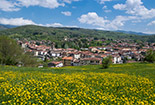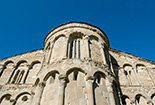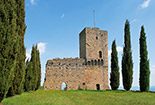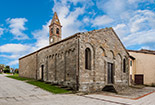The Church of Stia
in Casentino, a Tuscan valley with which you can get familiar in every detail through this site
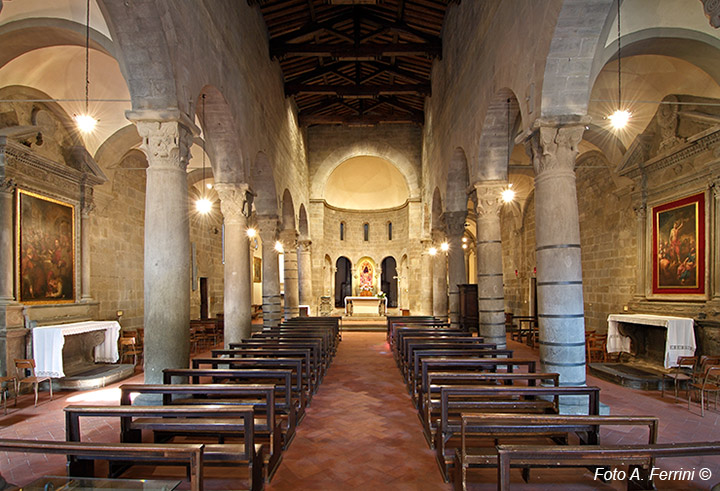
Texts and photos by Alessandro Ferrini ©
45 accurately described images of Pieve of Stia. Click to enlarge
The Parish Church of Saint Mary the Assumed in Stia
 From both the architectural and artistic points of view, the Romanesque parish church of Stia is considere one of the most interesting churches of the Casentino. It is located in the beautiful Tanucci Square and it is dedicated to Saint Mary of the Assumption. It almost camouflages itself in the surrounding architectural context because in 1776 its facade was rebuilt. It was drawn back a couple meters in order to be aligned with the adjacent buildings and to leave more room for the square, which in that period was the location of one of the most important markets of the Casentino. The style of its facade changed from Romanesque to late-Baroque.
From both the architectural and artistic points of view, the Romanesque parish church of Stia is considere one of the most interesting churches of the Casentino. It is located in the beautiful Tanucci Square and it is dedicated to Saint Mary of the Assumption. It almost camouflages itself in the surrounding architectural context because in 1776 its facade was rebuilt. It was drawn back a couple meters in order to be aligned with the adjacent buildings and to leave more room for the square, which in that period was the location of one of the most important markets of the Casentino. The style of its facade changed from Romanesque to late-Baroque.
Just after passing through the large entry door of the church, we will find ourselves immersed in a style five hundred years younger than the facade. Despite the several remakes and restoration works in the past centuries, the Parish Church of Stia has a clear Romanesque style inside. The nave and two side aisles separated by two lines of columns topped with elegant capitals, each one with different representations, is the obvious evidence of this. The covering of the central nave has the classic wooden trusses. The two side aisles have wooden beams, but they are no longer visible because during the 17th century they were covered by a masonry false ceiling .
The building of this church, demanded by the Guidi Counts belonging to the branch of Porciano, started around the second half of the 12th century and was actually following the Parish Church of Romena. The same Lombard masters surely took part in the making of the capitals of these two important churches for the ctiziens (which is the actual meaning of parish church), even though those of Stia look more refined and harmonious.
Today's Parish Church of Stia was built to replace a pre-existing church of smaller dimensions, but was still dedicated to Saint Mary of the Assumption. The construction date of this church is not known, but the first known document that mentions it belongs to the year 1017. The concrete evidence of this previous building came to light during an excavation and restoration  campaign in the years 1970-74, when the remains of the apsis and altar of this church were found under the floor. These findings are partly visible through two gratings located on the floor next to the high altar of today's church. Still on the event of the same excavations, the bases of two great cylindrical masonry columns were found underneath the central nave. They are evidence of the existence of a more ancient worship building in this area, probably dating back to the Etruscan-Roman period. These findings too are visible through two grates.
campaign in the years 1970-74, when the remains of the apsis and altar of this church were found under the floor. These findings are partly visible through two gratings located on the floor next to the high altar of today's church. Still on the event of the same excavations, the bases of two great cylindrical masonry columns were found underneath the central nave. They are evidence of the existence of a more ancient worship building in this area, probably dating back to the Etruscan-Roman period. These findings too are visible through two grates.
In 1770, a few years before the remaking of the facade, the apse of the Parish Church of Saint Mary the Assumed of Stia was removed in order to make room for a new great chorus. The original semicircular Romanesque structure was replaced by a great square plan chapel topped by a dome. In addition, two chapels were built near the two side aisles. In 1925, with the occasion of a substantial restoration work, a sort of apsis was built within the great central chapel. Still on the same occasion, some architectural elements were removed because they spoiled the original Romanesque style.
The bell tower is located halfway in the right-hand wall of the parish church. Its lower part is coeval with the church, while its top was renovated several times. The bell cell dates back to the 17th century, the clock to 1850 instead.
The Guidi Counts of Porciano also wanted their burial ground in this area. This is testified by two tombs found in 1956 in a place adjacent to the church (ground floor of today's rectory). Proof that connects this building to the Romanesque parish church is the date 1298 found on a window architrave and nowadays is prominently displayed on its facade.
The Parish Church of Stia is a place not only of high historical and architectural value, but there are also conserved very fine art works of different genres that embrace a period of five centuries. The most ancient piece of art is a Virgin Mary with Child painted on plank dating back to 1280/90. The painting has not been attributed with certainty to anybody yet; it is thought to be done by some important painter close to Cimabue or an anticipator of Giotto's style. It is also mentioned the name of the Master of Varlungo already present in the Casentino with another Virgin Mary with Child (nowadays preserved in the Rectory of Pratovecchio). Other important works present inside the Parish Church of Stia are: a Bicci di Lorenzo Annunciation of 1414 placed in the Baptistery, where there is also a 15th century fresco from a Florentine school which shows a Nativity, an Assumption of the Virgin by the Master of Borgo alla Collina (around 1420) located as the high altar-piece; a Virgin Mary with Child among Saints by the Master of San Miniato (second half of the 15th century); a white glazed ceramic Virgin Mary with Child by Andrea della Robbia (approximately 1490); a ciborium still made of polychrome glazed terracotta by Santi and Benedetto Buglioni (about 1525); a 15th century wooden crucifix from a Florentine school; a 1596 canvas painting attributed to Simone Ferri, which shows Jesus having dinner at the house of the Pharisee; an 18th century "Preaching of the Baptist" by Domenico Ferretti.
The painting has not been attributed with certainty to anybody yet; it is thought to be done by some important painter close to Cimabue or an anticipator of Giotto's style. It is also mentioned the name of the Master of Varlungo already present in the Casentino with another Virgin Mary with Child (nowadays preserved in the Rectory of Pratovecchio). Other important works present inside the Parish Church of Stia are: a Bicci di Lorenzo Annunciation of 1414 placed in the Baptistery, where there is also a 15th century fresco from a Florentine school which shows a Nativity, an Assumption of the Virgin by the Master of Borgo alla Collina (around 1420) located as the high altar-piece; a Virgin Mary with Child among Saints by the Master of San Miniato (second half of the 15th century); a white glazed ceramic Virgin Mary with Child by Andrea della Robbia (approximately 1490); a ciborium still made of polychrome glazed terracotta by Santi and Benedetto Buglioni (about 1525); a 15th century wooden crucifix from a Florentine school; a 1596 canvas painting attributed to Simone Ferri, which shows Jesus having dinner at the house of the Pharisee; an 18th century "Preaching of the Baptist" by Domenico Ferretti.
The works mentioned and other aspects of the Parish Church of Stia are shown and described in details in the photo gallery of this web section.



